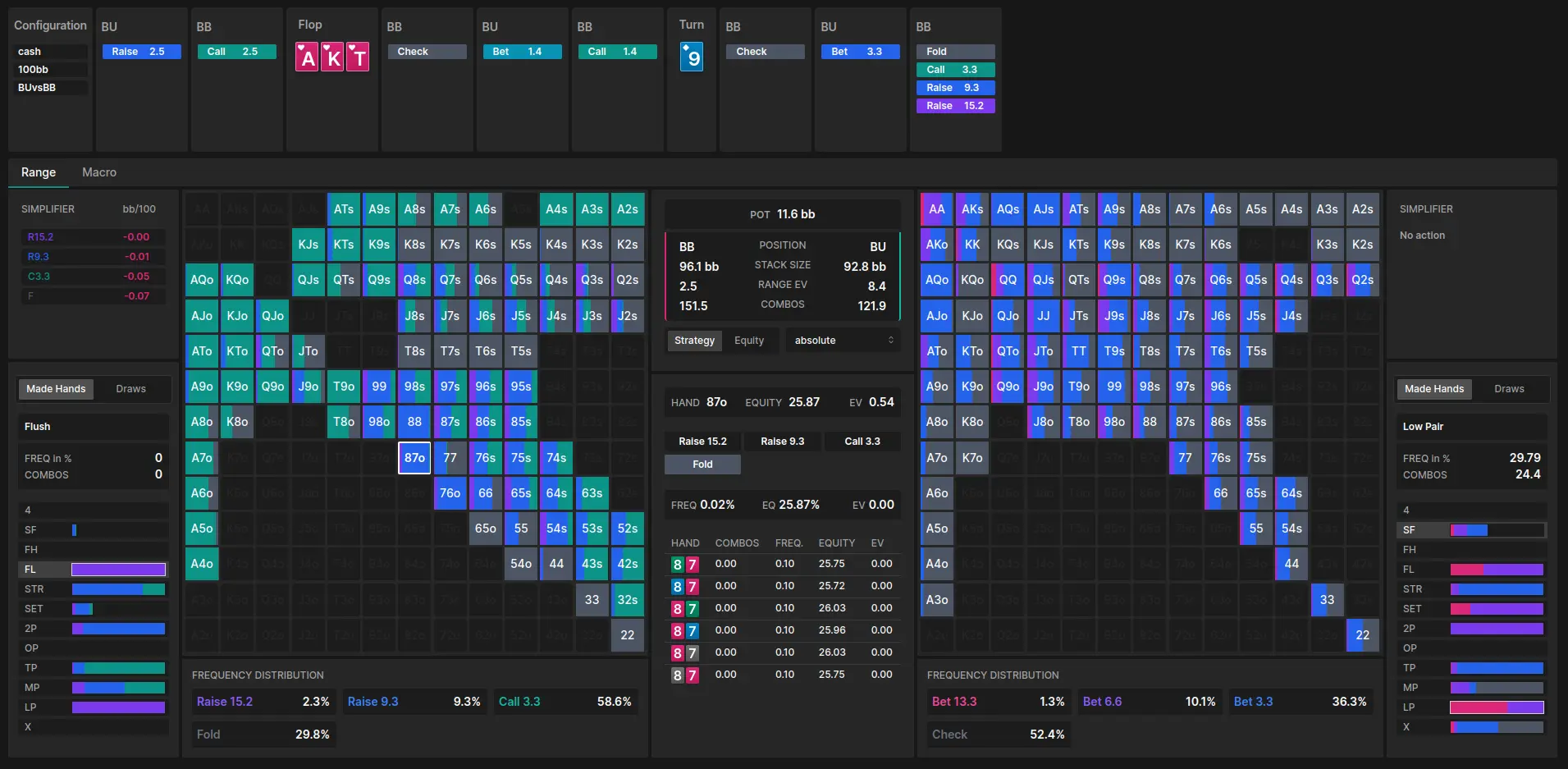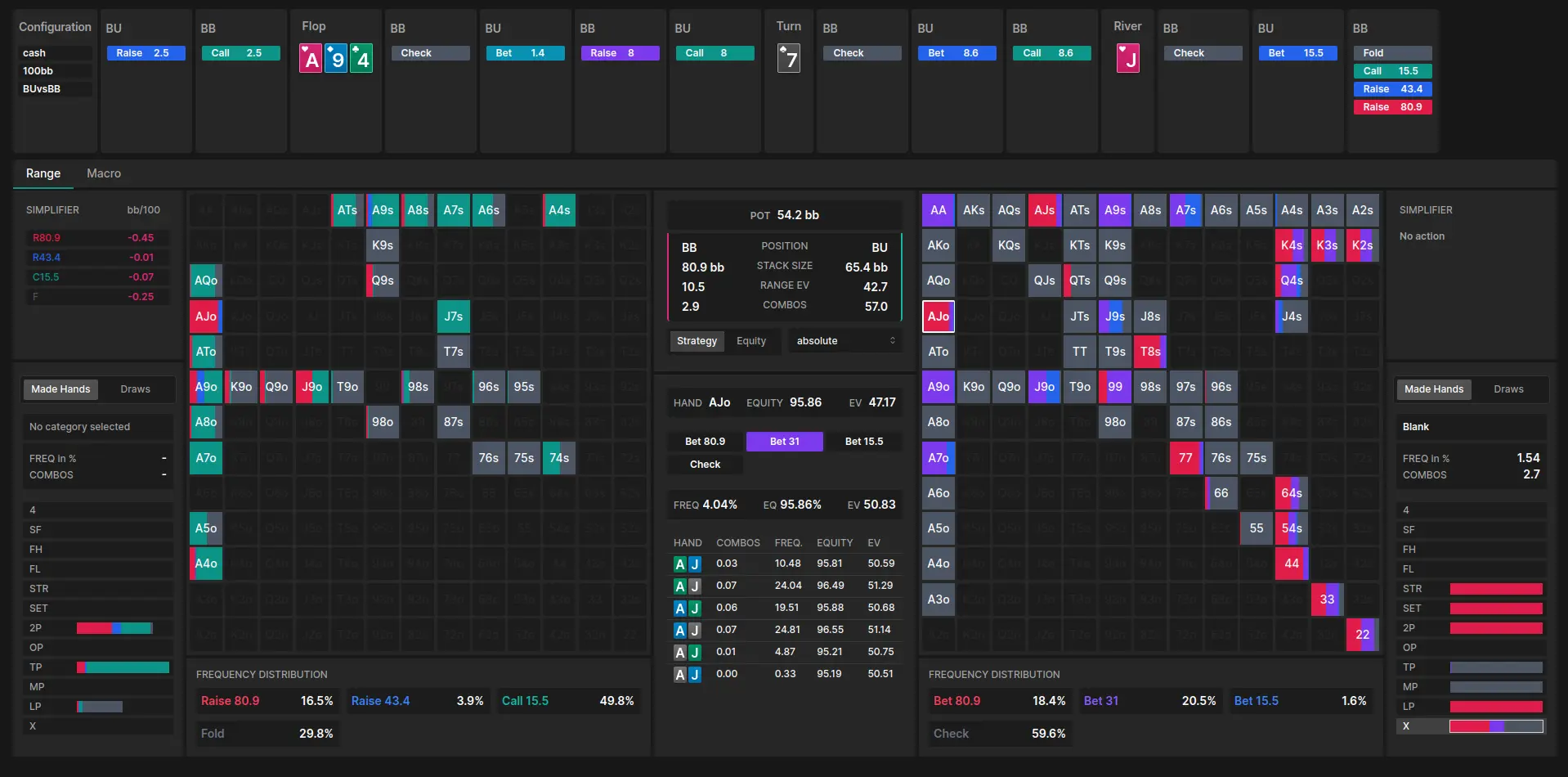poker scientist
Game Theory Optimal Strategy Platform
Challenge
Professional poker players knew optimal strategies existed mathematically but couldn't access them practically. Calculating Nash equilibria for poker situations requires processing near-infinite permutations—every bet size creates new branches in an already explosive decision tree. Existing solutions were academic toys, not production tools.
Solution
We pioneered the first user-facing GTO platform by solving two problems simultaneously: computational efficiency and cognitive accessibility. Built custom abstraction algorithms that reduced infinite situations to tractable calculations, then designed clustering visualizations that revealed strategic patterns humans could actually learn and apply.
Led frontend architecture migration from Angular to Next.js, prioritizing long-term stability and developer velocity. Engineered card matrix UI displaying equity, monetary values, and probabilities in scannable formats. Integrated C++ Nash solver with Node.js API layer, optimizing for both calculation speed and user experience. Designed adaptive visualization components that maintained clarity while presenting complex multi-dimensional data.
Full-Stack SaaS Platform Built for Professional Poker Players
Poker Scientist is a Game Theory Optimal (GTO) strategy platform I co-founded and scaled from concept to 500 paying users over 7 years. The SaaS application solves one of poker's most complex computational challenges: making Nash equilibrium strategies accessible and actionable for human players.
The Technical Challenge: Nash Equilibrium at Scale
Calculating optimal poker strategies requires processing near-infinite game states. Every bet size creates exponential branches in decision trees, making traditional brute-force approaches computationally impractical. Professional poker players knew optimal strategies existed mathematically but couldn't access them in practice—existing solutions were academic toys, not production tools.
The Solution: Computational Efficiency Meets Cognitive Accessibility
As Technical Lead and Frontend Architect, I pioneered the first user-facing GTO platform by solving two problems simultaneously:
1. Computational tractability - Custom abstraction algorithms reduced infinite situations to calculable game states 2. Cognitive accessibility - Clustering visualizations revealed strategic patterns humans could learn and apply
Key Technologies:
- Frontend: Next.js, React, TypeScript, Tailwind CSS, Framer Motion
- Backend: Node.js with custom C++ Nash equilibrium solver integration
- Database: PostgreSQL for managing millions of poker game states
- Infrastructure: Vercel for deployment, Stripe & Chargebee for payment processing
- Architecture: Full-stack application with RESTful API layer
Business Impact & Product Market Fit
Scaled to 500+ active users across three-tier SaaS pricing ($29-$75/month), achieving product-market fit in a highly specialized vertical requiring both technical sophistication and deep domain expertise. The platform operated profitably for 7 years in a competitive market, with users reporting measurable improvements in their real-game win rates.
Technical Contributions:
- Designed card matrix UI components displaying equity distributions, monetary values, and probabilities in scannable formats
- Integrated C++ calculation engine with Node.js API layer, optimizing for both computational speed and user experience
- Engineered adaptive visualization components maintaining clarity while presenting complex multi-dimensional data
- Led Angular to Next.js migration, improving performance 30%+ while reducing technical debt
Why This Project Demonstrates Full-Stack Excellence
Poker Scientist showcases end-to-end software engineering: from computational algorithms to production-grade UI, from payment infrastructure to customer lifecycle management, from architectural decisions to sustainable business operations. The 7-year timeline proves not just technical capability but product thinking, market understanding, and operational maturity.
Technologies & Skills Demonstrated: Full-stack development, SaaS architecture, payment integration, frontend framework migration, data visualization, API design, PostgreSQL database management, production deployment, technical leadership, product-market fit validation
Timeline: 2018-2025 | Role: Co-Founder & Technical Lead
Screenshots






Frontend
Backend
Tools & Services
Database
Impact
Scaled to 500+ active users with three-tier SaaS model ($29-$75/month). Achieved product-market fit in specialized vertical requiring both technical sophistication and domain expertise. Operated profitably for 7 years in competitive market. Users reported applying learned strategies to improve win rates in real games.
Key Learnings
- Frontend architecture migration: Successfully transitioned from Angular to Next.js, improving performance 30%+ while reducing technical debt
- Computational efficiency: Built custom abstraction algorithms that made near-infinite game states tractable for real-time calculation
- Cognitive accessibility: Designed clustering visualizations that revealed strategic patterns humans could learn and apply